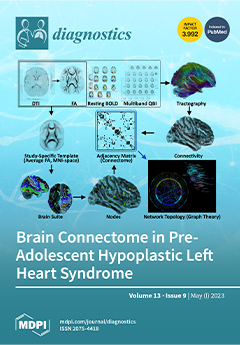Open AccessArticle
MMP-13, VEGF, and Disease Activity in a Cohort of Rheumatoid Arthritis Patients
by
Mihail Virgil Boldeanu, Lidia Boldeanu, Oana Mariana Cristea, Dana Alexandra Ciobanu, Sabin Ioan Poenariu, Anda Lorena Dijmărescu, Andreea Lili Bărbulescu, Vlad Pădureanu, Teodor Nicuşor Sas, Ștefan Cristian Dinescu, Florentin Ananu Vreju, Horațiu Valeriu Popoviciu and Răzvan Adrian Ionescu
Viewed by 1790
Abstract
Identifying certain serum biomarkers associated with the degree of rheumatoid arthritis (RA) activity can provide us with a more accurate view of the evolution, prognosis, and future quality of life for these patients. Our aim was to analyze the presence and clinical use
[...] Read more.
Identifying certain serum biomarkers associated with the degree of rheumatoid arthritis (RA) activity can provide us with a more accurate view of the evolution, prognosis, and future quality of life for these patients. Our aim was to analyze the presence and clinical use of matrix metalloproteinase-13 (MMP-13), along with vascular endothelial growth factor (VEGF) and well-known cytokines such as tumor necrosis factor-alpha (TNF-α) and interleukin 6 (IL-6) for patients with RA. We also wanted to identify the possible correlations between MMP-13 and these serological markers, as well as their relationship with disease activity indices, quality of life, and ultrasonographic evaluation. For this purpose, we analyzed serum samples of 34 RA patients and 12 controls. In order to assess serum concentrations for MMP-13, VEGF, TNF-α, and IL-6, we used the enzyme-linked immunosorbent assay (ELISA) technique. Our results concluded that higher levels of MMP-13, VEGF, TNF-α, and IL-6 were present in the serum of RA patients compared to controls, with statistical significance. We furthermore identified moderately positive correlations between VEGF, MMP-13, and disease activity indices, as well as with the ultrasound findings. We also observed that VEGF had the best accuracy (97.80%), for differentiating patients with moderate disease activity. According to the data obtained in our study, that although MMP-13, TNF-α and C-reactive protein (CRP) have the same sensitivity (55.56%), MMP-13 has a better specificity (86.67%) in the diagnosis of patients with DAS28
(4v) CRP values corresponding to moderate disease activity. Thus, MMP-13 can be used as a biomarker that can differentiate patients with moderate or low disease activity. VEGF and MMP-13 can be used as additional parameters, along with TNF-α and IL-6, that can provide the clinician a better picture of the inflammatory process, disease activity, and structural damage in patients with RA. Our data can certainly constitute a start point for future research and extended studies with multicenter involvement, to support the selection of individualized and accurate therapeutic management strategies for our patients.
Full article
►▼
Show Figures






